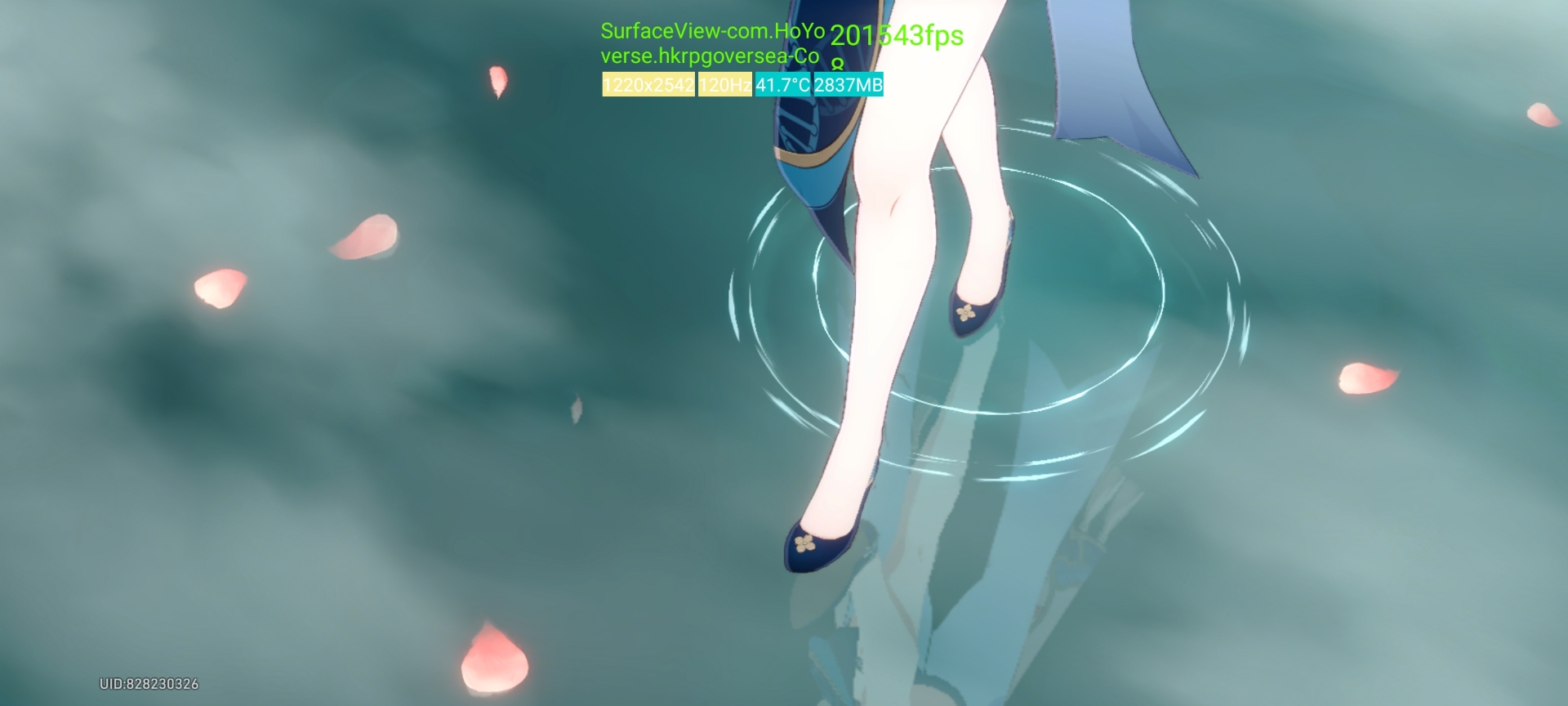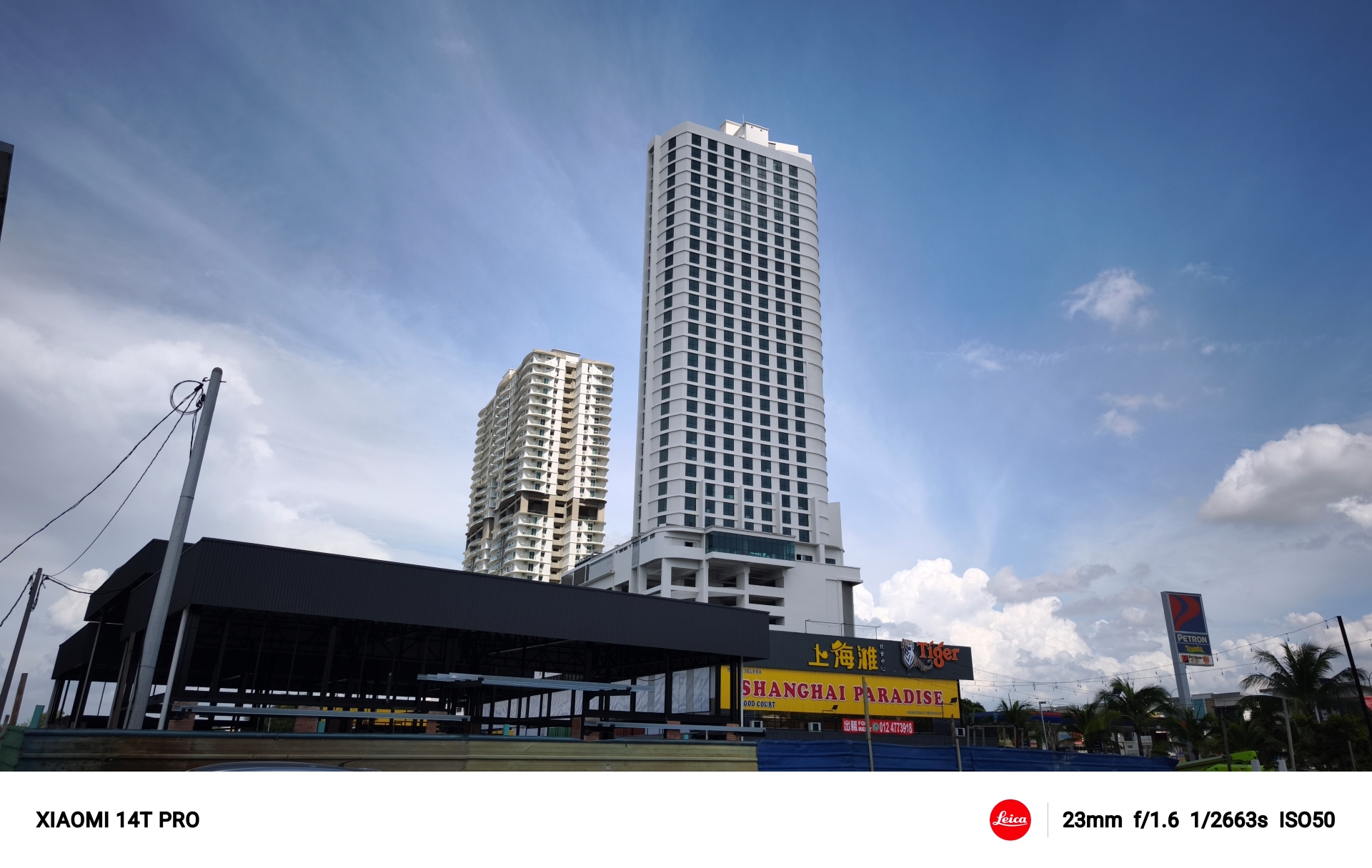Xiaomi T series phones are positioned below the flagship numbered series phones. They provide flagship-level specs and performances but at a more affordable price range. This year’s models aim for exactly that and here is our review of the XiaoMi 14T Pro smartphone that recently landed in our Malaysian market.
The Packaging:
The Xiaomi 14T Pro arrives in a white box with lettering detailing the phone inside it, along with a Leica logo. Inside it, are the Xiaomi 14T Pro smartphone and a black solid TPU case. The solid colored case baffles me, as it hides the Xiaomi 14T Pro’s beautiful Titan Blue colorway and I would have preferred a clear transparent case exactly to show the phone’s color. Rounding up the contents are a sim eject tool, a charging/data cable, and documentation.

Yes, you did not misread nor did I make an error of omission. Xiaomi has decided NOT to include a charger in the box. Instead, Xiaomi offers the 120W charging adapter separately as a gift when ordering the Xiaomi 14T Pro from their Mi.com website.
The Phone itself:
The Xiaomi 14T Pro features a glass back with curved corners and edges, moving into the aluminium frames. The Titan Blue colorway is matte finished, with matching colors found on the camera bump and the camera housings. The back is rather resistant to fingerprints, though some oily marks will accumulate and thus still need to be cleaned from time to time.

The camera bump has a new design away from the numbered Xiaomi 14 series. Featuring four individual housing rings for the three rear cameras and one for the flash. The camera housing rims are raised higher than the camera glasses, so the lenses are somewhat protected when the phone is placed on the back.
The aluminium alloy sides are finished in the same Titan Blue color, giving the Xiaomi 14T Pro a uniform look. With rounded edges and curvature towards the back, the Xiaomi 14T Pro feels great when holding the phone for gaming.

The Xiaomi 14T Pro front is a 6.67-inch flat 12-bit color AMOLED screen, and up to 144Hz refresh rate. The screen is the same as the Xiaomi 13T Pro, with HDR10+ and Dolby Vision support with a peak brightness of 4,000 nits. Completing the front is the in-display optical fingerprint reader which is responsive and accurate.

Another available color option for Malaysia for the IP68-rated Xiaomi 14T Pro is the Titan Black, as we are not getting the Titan Gray color option here.
Specifications at a glance:
| Price | 12GB + 256GB – RM2,599 12GB + 512GB – RM2,999 12GB + 1 TB – RM3,499 |
| Dimension | 160.4 x 75.1 x 8.4 mm |
| Weight | 209 grams |
| IP Rating | IP68 dust/water resistant (up to 2m for 30 min) |
| Material | Display – Corning Gorilla Glass 5 Back – Panda X Glass Chassis – Aluminium Alloy |
| Colour | Titan Blue Titan Black |
| Display | AMOLED, 68B colors, 144Hz, Dolby Vision, HDR10+, 1600 nits (high brightness), 4000 nits (peak) |
| Resolution | 1220 x 2712 pixels, 20:9 ratio (approx. 446 ppi density) |
| Display Size | 6.67 inches (approx. 89% screen-to-body ratio) |
| Operating System | Android 14, HyperOS |
| Chipset | Mediatek Dimensity 9300+ (4 nm) |
| Memory | 12GB + 256GB 12GB + 512GB 12GB + 1 TB |
| External Memory Card Slot | No |
| Main Camera | 50 MP, f/1.6, 23mm (wide), 1/1.31″ sensor, PDAF, OIS 50 MP, f/2.0, 60mm (telephoto), 1/2.88″ sensor, PDAF, 2.6x optical zoom 12 MP, f/2.2, 15mm (ultrawide), 1/3.06″ sensor |
| Main Camera Video | 8K@24/30fps, 4K@24/30/60fps, 1080p@30/60/120/240/960fps, gyro-EIS, 10-bit Rec. 2020, HDR10+ |
| Selfie Camera | 32 MP, f/2.0, 25mm (wide), 1/3.44″ sensor |
| Selfie Camera Video | 4K@30fps, 1080p@30/60fps, HDR10+ |
| Sound | Stereo, Dolby Atmos, Xiaomi Sound, 24-bit/192kHz Hi-Res & Hi-Res Wireless audio |
| WLAN | Wi-Fi 802.11 Wi-Fi 802.11 a/b/g/n/ac/6e/7, dual-band, Wi-Fi Direct |
| Bluetooth | A2DP, 5.4, A2DP, LE, LHDC |
| USB | USB Type-C 2.0, OTG |
| Battery | 5000 mAh, non-removable |
| Charging | 120W wired, PD3.0, QC4 50W wireless |
Display and Battery:
XiaoMi 14T Pro features a 6.67-inch CrystalRes AMOLED display, with a resolution of 1220×2712 pixels, and is capable of up to 144Hz refresh rate. The display supports Dolby Vision and HDR10+ with 4,000-nits of peak brightness, 2,880Hz PWM dimming, and 480Hz tough sampling rate. Typical screen brightness is around 1,600 nits, great for using the Xiaomi 14T Pro outdoors, even gaming.
As usual, Xiaomi default color setting of “Original color PRO” which has a more flat and less saturated color. I changed the color scheme setting to Vivid as it is a matter of personal preference.

The battery capacity on the XiaoMi 14T Pro is 5,000mAh, again something carried over from is Xiaomi 13T Pro. While the Xiaomi 14T Pro is capable of 120W charging, it doesn’t ship one in the box. Xiaomi instead makes the 120W charging adapter a gift with purchase. There is no indication if the gift will be available perpetually, so do be warned. Even the Xiaomi 14T does not come with a charger either.

As I don’t have a Xiaomi 120W charger, I am unable to test this fast charging time for the Xiaomi 14T Pro. By using other chargers, charging the Xiaomi 14T Pro battery from 10% to full takes about 55 minutes. Even with the Boost Charging Speed option turned on, charging times don’t improve significantly, perhaps that option only affects the Xiaomi charging solutions.
Also not tested was the wireless charging capabilities, as am is without an appropriate wireless charger.
Gaming on the Xiaomi 14T Pro:
As per the usual BunnyGaming mobile gaming stress test of a smartphone, I subjected the Xiaomi 14T Pro’s Mediatek Dimensity 9300+ chipset to our regular trio of Hoyoverse games of Genshin Impact, Honkai: Star Rail, and Zenless Zone Zero.
Genshin Impact is set to the highest graphic setting and 60FPS. As expected of the Mediatek Dimensity 9300+ flagship status, the overall framerate experience is very good and stable. Maintaining high 57 to 60 FPS when the game is less hectic. During the more frantic battles with lots of elemental effects, the Xiaomi 14T Pro buckles a bit to drops more frames, with the low 45 FPS noticed. Similarly, the lower 50s FPS is evident when teleporting into a new area.

Loading up Honkai: Star Rail next, again with the graphical settings set to the maximum of Highest and 60FPS. Framerates are mostly stable, keeping 57 – 60FPS during traversal. In hectic battles and after load-in, the framerates dip towards the mid-50s in battles when much effect is covering the screen. Worse are with the character’s ultimate animation and effects, when the framerates drop to the high 40+ FPS.

Zenless Zone Zero is up next, being the most demanding of these Hoyoverse games, pushing the Xiaomi 14T Pro much harder. While traversal remains stable at 57 to 60FPS most of the time, loading into a new area draws in at the mid-50s FPS. Battles buckle the Mediatek Dimensity 9300+ hard. In battles with many mobs at the same time, or during intense boss fights, the lowest recorded was at 43 FPS.

While the dips are noticeable when it does happen, mainly because I am actively looking out for it, impressively it does not happen that often throughout the two hours plus sessions I had playing the games on the Xiaomi 14T Pro. I would even reckon that most mobile gamers would not notice the dips that much as the Xiaomi 14T Pro is very quick to recover. Another option is to lower the graphic settings by a wee bit, and we are all set for smooth 60FPS gaming.

The good news is that the Xiaomi 14T Pro doesn’t throttle the Mediatek Dimensity 9300+ even with two-hour sessions, thus keeping the framerate performances stellar. Another positive is that the rear of the Xiaomi 14T Pro does not heat up a lot during gaming sessions. Temperatures are recorded at 41 to 42℃ as the highest after the gaming sessions.

Battery consumption is good as well. An hour of gaming with the above said games consumes about 20 to 25% of battery power. For regular users, Xiaomi 14T Pro’s 5,000mAh battery will power through the whole day. With moderate to heavy usage of social media, web surfing, chatting, and calls, and some short photography and gaming sessions, Xiaomi 14T Pro ended the day with 10% juice left in the tank.

The top and bottom speaker produces a good audio experience for gaming. The sound comes out clear and detailed, though the bass is kinda lacking. Dolby Atmos processing is available, another option is the Xiaomi Sound. Using Bluetooth IEM and headphones, I found that Xiaomi Sound produces a slightly louder sound, while Dolby Atmos is more convincing at producing a simulated multi-speaker setup.
The Cameras:
The main camera is now the very same as the Xiaomi 14 main camera, a 50MP Omnivision OV50H, with a 1/1.3” sized, f/1.6 aperture 23mm focal length sensor. This sensor, which Xiaomi named Light Fusion 900, is a common camera used in several flagship phones from different brands in 2024. As experienced with Xiaomi 14, the main camera takes great-looking photos in daylight. Images are detailed and crisp, with very little noise even with pixel peeped.

The telephoto camera is also different, utilizing another widely used sensor, a 50MP Samsung JN1 with a 1/2.76” sensor, f/2.0 aperture, and 60mm focal length or 2.6x zoom. The ultra-wide camera is retained from the Xiaomi 13T Pro, a 13MP Omnivision OV13B 1/3” sensor 15mm wide f/2.2 sensor. Notably, only the main camera gets the OIS treatment.
The telephoto camera likewise produces detailed and sharp images. Care has to be given to the 2.6x optical zoom and the 5x digital zoom or above, as the telephoto sensor does not have any Optical Image Stabilization employed. In daylight, 10x zoom images are usable for social media postings. Any longer zoom than 10x will result in blurry and smudgy images, so I would stay away from those 20x and 30x digital zoom shots.







Night shots with some lights turn out great as well with the main camera, with good details and colors preserved. Night mode will automatically kick in when the Xiaomi 14T Pro detects that the scene is dark. If any zoom is needed, the 2.6x is the longest I would go to, as anything above will be blurry and with much noise detected.


Portrait mode defaults to preset focal lengths in mm rather than the zoom lengths. The four preset focal lengths are 23mm, 35mm, 60mm, and 73mm; notably the 23mm and 60mm are the main camera and the telephoto camera. I will never use the 23mm in portrait mode as it is too wide, to which the 35mm is a much better option. Both these focal lengths provide minimal bokeh effect, so the other two longer focal lengths are better. The 60mm and 73mm produce a better bokeh effect, with good separation processing. Do note that these two longer focal lengths use the telephoto camera that has no OIS, so do keep the Xiaomi 14T Pro steady when using these two focal lengths for portrait shots.



The Xiaomi 14T Pro Ultra-Wide camera is very good despite the lower MP count, with good details and color reproduction, in daylight, with no corner vignetting. Night shots can get noisier and blurry when it is rather dark. The 32MP selfie camera takes respectable shots in both daylight and brighter areas when night, perfectly shareable on social media and chatting apps.

Xiaomi and Leica partnership continues with the Xiaomi 14T Pro. Leica provides the Leica-Sumilux lenses for the rear cameras, as well as the same Leica Vibrant and Leica Authentic shooting styles to choose from, and a plethora of Leica filters to choose from. Color and contrast will depend on the Leica styles chosen. Leica Authentic produced more real-to-life colors and more contrast, with some vignetting darker corners, while Leica Vibrant turns up the color saturation more. I liked the Leica Vibrant with its brighter imaging and vibrant colors that are more pleasing to the eyes.

As for video, the main rear camera can take up to 8K30fps, while the other cameras up to 4K30fps, including the front selfie camera. Steady Video mode with EIS is capped at 1080p30fps. Videos can be shot in HDR10+ mode, or with Xiaomi’s Master Cinema mode that enables REC2020 HDR recording.
For those who prefer to post-process images and videos, Xiaomi 14T Pro can shoot images in JPG and RAW formats, and videos in h.264 or h.265 and LOG formats. These unprocessed RAW and LOG formats can only be accessed in the camera Pro mode.
Software:
XiaoMi 14T Pro ships with HyperOS, currently in the V1.08 version per the latest update. arrives with the new OS installed. While the Xiaomi 14T Pro is in line to get the HyperOS 2.0 update, it has not been pushed out for the review unit. HyperOS is faster and more responsive, and with most Android 14 smartphones, Xiaomi has opted to split the notification tab and the control panel tab to the top left and top right of the phone.
In the usual HyperOS style, Xiaomi’s native apps like Music, Video, Theme, and Game Center send plenty of notification suggestions for you to try out. Whether this is a feature or a nuisance is entirely up to your preference, I had it off.

The good news is Xiaomi 14T Pro will be getting four years of OS support and five years of security updates, well into 2028 and beyond. This level of support is available for flagship smartphones, and it is great that Xiaomi is also delivering the same for the Xiaomi 14 series phones
AI Functionalities:
As with most smartphones released in the second half of 2024, Xiaomi 14T Pro comes with a suite of AI functionalities, with Google’s Gemini incorporated into Android 14 and thus HyperOS. Gemini chatbot can be directly accessed by long pressing the power button.

AI Image Editing: Found in the photo gallery app, select an image, then “Edit”, then “Create” will bring up the AI image eraser. Remove Objects by circling them, Remove Lines such as power cables across the image, and Remove People by tapping on them are the options available, or you can manually draw on the items to be removed. Always tap on the top right “Pro” mode as this uses a data connection to the servers to better recompose the image. While there is a basic eraser without connecting to the server, the results are rather bad.


Circle to Search: Tap and hold on to the bottom highlight bar on the screen that brings up Google’s Circle to Search. Circle anything on the screen, on image, video, or text, and it will result in a Google search results page that identifies the item being circled. Works like Google Lens but it’s available system-wide at a touch.
AI Interpreter: Found in the control panel tab by swiping down from the top right of the Xiaomi 14T Pro on a button named “Interpert Audio”. Xiaomi 14T Pro will translate between two spoken languages to each other, for example from English to Mandarin Chinese and vice versa. Useful when traveling, and this AI Interpreter works in 28 languages with most ASEAN languages covered. This AI Interpreter works face-to-face, in meetings, and even in calls.


AI Notes: Utilizes AI for note taking, proofreading, notes summary, layout, and translations.
AI Recorder: Speech-to-text function, meeting transcription, summary, and translation, with speaker recognition.
AI Subtitles: Uses AI to provide subtitles for videos watched, or translated subtitles to the 28 language models available.

Do take note that almost all of the AI functions mentioned above require a connection to the internet, to download the software patches needed for each function and for the large language model (LLM) processing. Another point to that note is that some of the AI photo regeneration, translations, and subtitling are far from perfect, although I foresee it will get better with time as the AI LLM learns more with more submissions.
In summary:
What I Really Liked About the Xiaomi 14:
- Price
- Flagship CPU, with the Mediatek Dimensity 9300+
- Great gaming performance
- Great display
- Great image quality from the cameras
- 90W fast charging and 50W wireless charging
What I Wished Was Better
- Charging brick given as a gift, not included with purchase
- Solid black colored TPU case, covering the beautiful back
- Less intrusive ad notifications from HyperOS
Verdict:
The Xiaomi 14T Pro is perfectly priced for a smartphone with flagship specs and features. The Mediatek Dimensity 9300+ chipset is a great flagship chipset, even if the new Dimensity 9400 has just been launched. The main camera that is lifted from the flagship Xiaomi 14 phone launched earlier this year. 120W wired charging and 50W wireless charging as well this time round. And a very capable gaming smartphone with very few compromises.

All these flagship features for a mid-range asking price starting from RM2,599. Which is a steal and a great buy in my books, and to my wallet.




